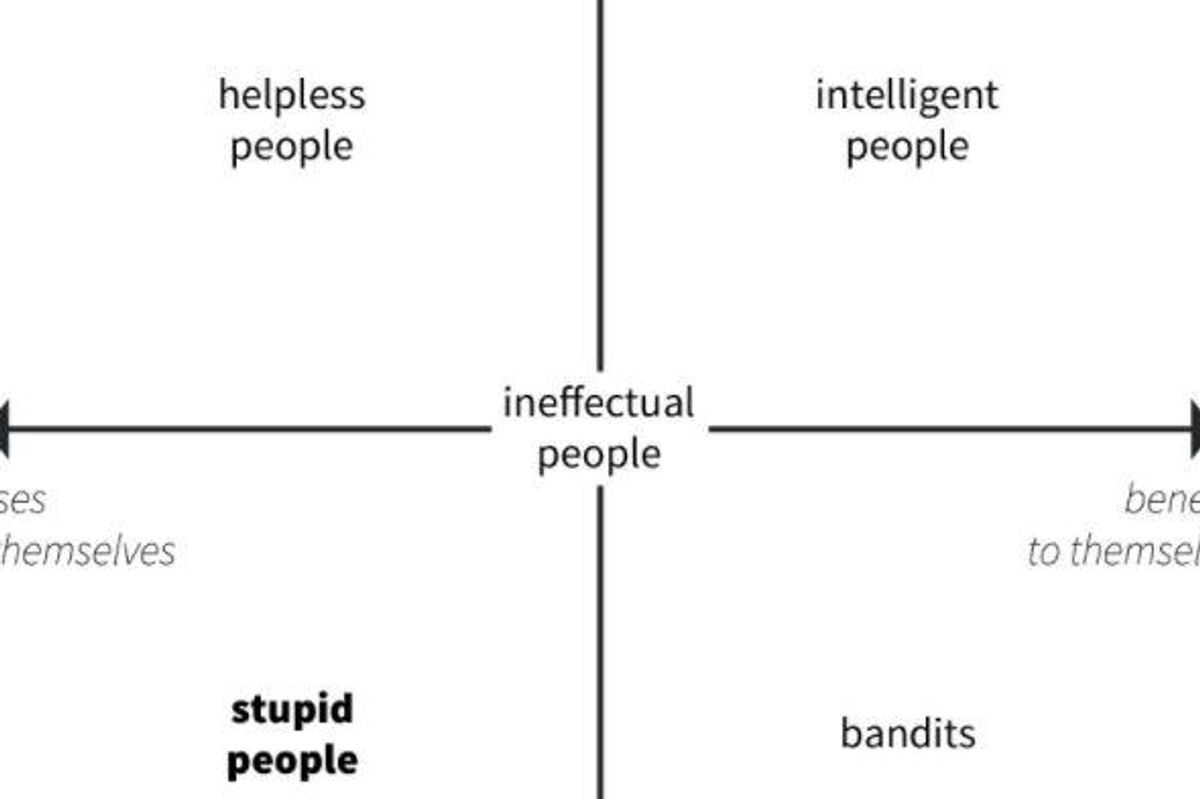A lighthearted, simple matrix explains whether someone is 'intelligent' or 'stupid'

Cipolla's graph with the benefits and losses that an individual causes to him or herself and causes to others.
Have you ever known someone who was educated, well-spoken and curious, but had a real knack for making terrible decisions and bringing others down with them? These people are perplexing because we're trained to see them as intelligent, but their lives are a total mess.
On the other hand, have you ever met someone who may not have a formal education or be the best with words, but they live wisely and their actions uplift themselves and others?
In 1976, Italian economist Carlo Cipolla wrote a tongue-in-cheek essay called "The Basic Laws of Human Stupidity" that provides a great framework for judging someone's real intelligence. Now, the term "stupid" isn't the most artful way of describing someone who lives unwisely, but in his essay Cipolla uses it in a lighthearted way.
Cipolla explains his theory of intelligence through five basic laws and a matrix that he believes applies to everyone.
First Basic Law
"Always and inevitably everyone underestimates the number of stupid individuals in circulation."
Cipolla believes that the mind can hardly comprehend the sheer amount of stupid people that exist in the world. In his first law he asserts that "any numerical assumption would turn out to be an underestimate."
"Stupid people are the most dangerous type of people."

Stupid people's actions are counterproductive to themselves and others.
Helpless people contribute to society and can be altruistic or moral. But they're often taken advantage of or give much more than they receive.
Bandits are opportunists that pursue their own self-interest even if it harms others.
Intelligent people contribute to society and leverage their contributions into reciprocal benefits.
Cipolla's basic laws may not be backed up by hundreds of pages of psychological research, but they help explain why seemingly intelligent people can make terrible decisions and why people who may not appear to be so bright can be beacons of wisdom.
The underlying truth of the matter is that intelligent people take smart actions and stupid people make dumb decisions. It doesn't matter how many books you've read or your social status. As Forrest Gump once said, "Stupid is as stupid does."
- 'Down syndrome is my superpower,' says 10-year-old model who ... ›
- Octopus intelligence: Here are 13 of the most frighteningly smart ... ›
- 5 applause-worthy quotes from Lady Gaga's candid conversation ... ›
- How do you know someone is smart? ›
- How do you know someone is smart? - Upworthy ›







 Beaver on riverbank.
Beaver on riverbank.  Pbs Nature Swimming GIF by Nature on PBS
Pbs Nature Swimming GIF by Nature on PBS  An actual beaver dam on the now-thriving Price River
An actual beaver dam on the now-thriving Price River 
 Hard to imagine Dick Van Dyke being "lazy."
Hard to imagine Dick Van Dyke being "lazy." 
 a piece of paper with a heart drawn on it Photo by
a piece of paper with a heart drawn on it Photo by 

 Dinosaur bones.Photo credit
Dinosaur bones.Photo credit  A jump and juggle.Photo credit
A jump and juggle.Photo credit  The widow.Photo credit
The widow.Photo credit  Overlooking a mountain adventure.Photo credit
Overlooking a mountain adventure.Photo credit  Looks like 6 feet under the covers.Photo credit
Looks like 6 feet under the covers.Photo credit  "Bow chicka bow wow!"
"Bow chicka bow wow!"  Two people sharing a milkshake. Photo credit
Two people sharing a milkshake. Photo credit